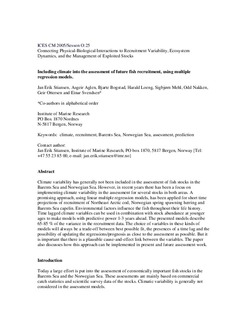| dc.contributor.author | Stiansen, Jan Erik | |
| dc.contributor.author | Aglen, Asgeir | |
| dc.contributor.author | Bogstad, Bjarte | |
| dc.contributor.author | Loeng, Harald | |
| dc.contributor.author | Mehl, Sigbjørn | |
| dc.contributor.author | Nakken, Odd | |
| dc.contributor.author | Ottersen, Geir | |
| dc.contributor.author | Svendsen, Einar | |
| dc.date.accessioned | 2007-07-10T12:38:00Z | |
| dc.date.issued | 2005 | |
| dc.identifier.citation | This report is not to be quoted without prior consultation with the General Secretary. | |
| dc.identifier.uri | http://hdl.handle.net/11250/100749 | |
| dc.description.abstract | Climate variability has generally not been included in the assessment of fish stocks in the Barents Sea and Norwegian Sea. However, in recent years there has been a focus on
implementing climate variability in the assessment for several stocks in both areas. A promising approach, using linear multiple regression models, has been applied for short time projections of recruitment of Northeast Arctic cod, Norwegian spring spawning herring and Barents Sea capelin. Environmental factors influence the fish throughout their life history. Time lagged climate variables can be used in combination with stock abundance at younger ages to make models with predictive power 1-3 years ahead. The presented models describe 65-85 % of the variance in the recruitment data. The choice of variables in these kinds of models will always be a trade-off between best possible fit, the presences of a time lag and the
possibility of updating the regressions/prognosis as close to the assessment as possible. But it
is important that there is a plausible cause-and-effect link between the variables. The paper also discusses how this approach can be implemented in present and future assessment work. | en |
| dc.format.extent | 123318 bytes | |
| dc.format.mimetype | application/pdf | |
| dc.language.iso | eng | en |
| dc.publisher | ICES | en |
| dc.relation.ispartofseries | ICES CM documents | en |
| dc.relation.ispartofseries | 2005/O:25 | en |
| dc.subject | fish stocks | en |
| dc.subject | hydrography | en |
| dc.title | Including climate into the assessment of future fish recruitment, using multiple regression models. | en |
| dc.type | Working paper | en |
| dc.subject.nsi | VDP::Agriculture and fishery disciplines: 900::Fisheries science: 920::Resource biology: 921 | |
| dc.subject.nsi | VDP::Mathematics and natural science: 400::Zoology and botany: 480::Ecology: 488 | |
| dc.source.pagenumber | 15 s. | en |
